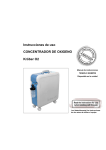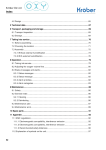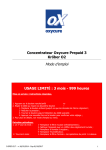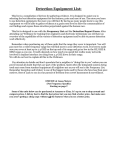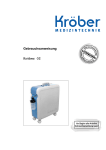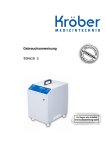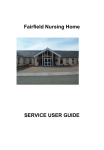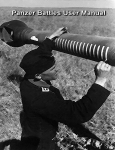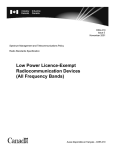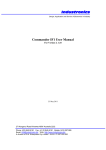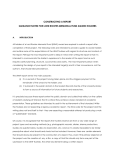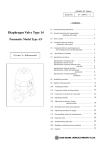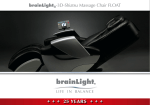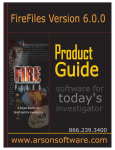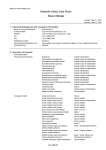Download Instructions for Use Kröber O2
Transcript
Instructions for Use Kröber O2 Kröber O2 © Kröber Medizintechnik GmbH Salzheck 4 D-56332 Dieblich Phone: +49 (0) 2607 9404 0 Fax: +49 (0) 2607 9404 22 E-Mail: [email protected] Internet: www.kroeber.de Dok-ID: KR02.00 Rev.: 3 2 Kröber O2 3 Kröber O2 1 Preliminary statement ........................................................................................................ 6 2 General................................................................................................................................. 7 2.1 Information in these instructions for use ......................................................................... 7 2.2 Declaration of Manufacturer ........................................................................................... 8 2.3 Type plate ....................................................................................................................... 9 2.4 Liability and warranty ...................................................................................................... 9 2.5 Warranty ......................................................................................................................... 9 2.6 Explanation of symbols................................................................................................. 10 2.7 Copyright protection...................................................................................................... 11 2.8 Return and waste disposal ........................................................................................... 11 2.9 Customer service.......................................................................................................... 11 3 Safety ................................................................................................................................. 12 3.1 General ......................................................................................................................... 12 3.2 Customer’s responsibility.............................................................................................. 12 3.3 Intended use ................................................................................................................. 13 3.4 Dangers which may arise from the unit ........................................................................ 13 3.5 What to do if a hose caught fire .................................................................................... 16 4 Design and function ......................................................................................................... 17 4.1 General description....................................................................................................... 17 4.2 Design........................................................................................................................... 17 5 Technical data ................................................................................................................... 19 6 Transport, packaging and storage .................................................................................. 21 6.1 Transport inspection ..................................................................................................... 21 6.2 Storage ......................................................................................................................... 21 7 Taking into service ........................................................................................................... 22 7.1 Before assembling ........................................................................................................ 22 7.2 Choosing the location ................................................................................................... 23 7.3 Assembly ...................................................................................................................... 24 7.3.1 Without external humidification............................................................................... 24 7.3.2 With external humidification ................................................................................... 26 4 Kröber O2 8 Operation............................................................................................................................28 8.1 Taking into service ....................................................................................................... 28 8.2 Adjusting the oxygen volume flow ................................................................................ 29 8.3 Alarms .......................................................................................................................... 30 8.3.1 Alarm priorities ....................................................................................................... 30 8.3.2 Alarm categories .................................................................................................... 31 9 Maintenance .......................................................................................................................35 9.1 Safety ........................................................................................................................... 35 9.2 General notes............................................................................................................... 35 9.2.1 Cleaning ................................................................................................................. 35 9.2.2 Disinfecting............................................................................................................. 35 9.3 Maintenance plan ......................................................................................................... 36 9.4 Maintenance work ........................................................................................................ 38 10 Spare parts .......................................................................................................................40 11 Appendix ..........................................................................................................................41 11.1 EMC regulations......................................................................................................... 41 11.1.1 Electromagnetic compatibility, interference emission .......................................... 41 11.1.2 Electromagnetic compatibility, interference emission .......................................... 42 11.1.3 Recommended safety distances .......................................................................... 45 11.2 Explanation of symbols on the unit............................................................................. 46 12 Index .................................................................................................................................48 5 Kröber O2 Preliminary statement 1 Preliminary statement Your doctor has found that you require an additional oxygen supply. With the Kröber O2 you received a German brand product for oxygen supply, which has been developed on the basis of the latest knowledge in both medical engineering and electronics. Permanent quality inspections ensure uniform quality on the highest level. The Kröber O2 is a highly reliable oxygen concentrator , intended for use in homes or at home, as well as for clinical applications. However, should problems arise with the Kröber O2, you may contact your dealer at any time. This medical care product from Kröber is labelled with the CE-sign according to MPG (Medical Product Law). Only use the Kröber O2 after a medical indication and only in compliance with the doctor's orders by following these instructions for use. If side effects or extreme health restrictions occur during the therapy, you should immediately consult your doctor. 6 Kröber O2 General 2 General 2.1 Information in these instructions for use These instructions for use describe the installation, operation and maintenance of the unit. Strict compliance with the stated notes on safety and instructions for use is a prerequisite for safe and proper work with the unit. Moreover, compliance with the accident prevention instructions valid at the location of use and the general safety regulations is mandatory. This instruction manual is part of the product and should be kept near the unit so that it is at any time available for personnel involved i installation, operation, maintenance and cleaning. The graphic illustrations in this manual may perhaps differ slightly from the actual design of the unit. 7 Kröber O2 General 2.2 Declaration of Manufacturer 8 Kröber O2 General 2.3 Type plate The type plate of the Kröber O2 is attached to the back of the unit above the coarse dust filter. 2.4 Liability and warranty All details and notes for the operation, maintenance and cleaning of the unit are made to the best of our knowledge taking into consideration our experience and knowledge gained up to now. We reserve the right to make technical changes to the machine dealt with in these instructions for use within the context of ongoing development. Translations are also carried out to the best of knowledge. We do not accept any liability for errors in translation. The German version of the instructions for use, which is also delivered with the unit, is the definitive version. Texts and illustrations do not necessarily correspond to the scope of delivery. The drawings and graphics are not to scale 1:1. Read instructions for use carefully before starting operation of the unit! The manufacturer will not assume liability for damage or disruptions that occur as a result of non-compliance with the instructions for use. Handing over these instructions for use to third parties is not permitted and results in the obligation for compensation. 2.5 Warranty Differing from our General Terms of Business we grant an extended warranty of 30.000 operating hours for all functional parts (e.g. compressor, control board, valve technology, etc.) used in our oxygen concentrator Kröber O2 . This extended warranty is valid for maximum 5 years from the date of purchase. This warranty does not cover filters and zeolites, damage caused by improper handling and mechanical damage of parts (e.g. transport damage). Our warranty is limited to the free-of-charge replacement delivery for defective parts. The defective components must be returned to us for inspection. Locally arising costs for travel and labour time will not be refunded. If units are returned to us free of charge for warranty repair we will also cover the labour costs for probable warranty repairs. 9 Kröber O2 General 2.6 Explanation of symbols Important safety and equipment related notes in these instructions for use are highlighted by symbols. These notes must be strictly adhered to in order to avoid accidents, personal injuries and damage to property. WARNING! This symbol warns of dangers that can lead to adverse effects on health, injuries, permanent physical damage or to death. Strictly comply with all notes regarding work safety, and be particularly careful in these situations. WARNING! Danger of electric current! This symbol draws attention to dangerous situations involving electrical currents. There is a danger of serious injury or death if the safety notes are not complied with. The related work may only be carried out by qualified electricians. ATTENTION! Information highlighted with this symbol must be strictly complied with in order to avoid damage to the machine, malfunction and/or breakdown. NOTE! This symbol highlights hints and information to be observed for efficient and nondisrupted operation of the unit. 10 Kröber O2 General 2.7 Copyright protection These instructions for use are to be treated confidentially. They should only be used by persons who have been authorized accordingly. It may only be passed on to third parties with the written consent of the manufacturer. All documents are protected by copyright protection law. It is not permissible to pass on or reproduce the documents, either as a whole or excerpts thereof, to evaluate or communicate their content, unless explicitly entitled to do so. Any violations are liable to prosecution and require compensation. We reserve the right to exercise industrial property rights. 2.8 Return and waste disposal – If the unit has been delivered through a parcel service and not directly by a dealer you should keep the packaging material for possible service instances. – If there is no corresponding agreement regarding the return of packing material, then the packing material remains with the customer. He is responsible for environmental waste disposal in accordance with the applicable waste disposal legislation. – After use the unit may be returned to the dealer, who is then responsible for proper disposal of the unit. – Non-infectious used accessories (e.g. nasal cannula) can be disposed off as domestic waste – Infectious accessories (e.g. nasal cannula of an infected user) must be disposed of through a specially approved waste disposal company. Addresses are available from your local municipality. 2.9 Customer service Service work should normally be carried out by your local authorized dealer. You can contact Kröber Medizintechnik GmbH as follows: Office hours: Mo-Thu from 7.30 a.m. - 4.00 p.m. and Fr. from 7.30 a.m. - 2.00 p.m. Address: Kröber Medizintechnik GmbH Salzheck 4 D-56332 Dieblich Phone: 02607-94040 Fax: 02607-940422 Internet: www.kroeber.de eMail: [email protected] 11 Kröber O2 Safety 3 Safety This section provides an overview over all important safety aspects for safe and trouble-free operation of the unit. The individual chapter additionally contain actual safety notes highlighted with symbols, which will help to avoid immediate dangers. 3.1 General The machine is built according to the currently applicable rules of technology and is safe to operate. However, dangers may still arise from the unit if it is incorrectly operated or used for purposes it is not intended for. Any persons using this unit must have read and understood these instructions before starting operation. This also applies if the person in question has already worked with just such a unit or similar equipment or was trained by the manufacturer. Knowing the content of these instructions for use is a prerequisite for the avoidance of mistakes and for safe and trouble-free operation of the unit. Neither changes nor conversions may be carried out on the equipment, which have not been explicitly authorized by the manufacturer, to avoid dangers and to ensure optimal performance. All safety decals and operating signs on the unit must be kept well legible at all times. Damaged or illegible decals must be replaced immediately. 3.2 Customer’s responsibility These instructions for use must be kept near the unit, so that it is available for the user at any time. Apart from the notes on safety mentioned in this manual, all generally valid safety and accident prevention instructions must also be observed and adhered to. The machine may only be operated in a technically perfect condition and if operationally safe. The information contained in the instruction manual is complete and must be adhered to without limitation. 12 Kröber O2 Safety 3.3 Intended use The operational safety of the unit is only assured when used for the purpose it is intended for, as specified in the instructions for use. The Kröber O2 solely intended for use within the scope of a medical therapy for the additional supply of oxygen. The unit may thereby be used in hospitals, homes or at home. The unit must only be used according to the medical indication and only in accordance with the doctor's prescription by following these instructions for use The intended use also includes the compliance with the assembly instructions, as well as the notes on cleaning and maintenance of the unit. Any other use of the unit beyond these limits is prohibited and is not considered as unintended use! Claims of any kind against the manufacturer and/or his authorized representatives resulting from damage caused by unintended use of the unit are excluded. The customer is solely liable for any damage resulting from unintended use. 3.4 Dangers which may arise from the unit The unit was subjected to a risk analysis. The resultant construction and design of the unit corresponds to the current status of technology. However, there is still a remaining risk! The unit requires responsibly minded and cautious operation. Improper operation or operation by unauthorized persons can endanger persons. WARNING! Risk of health damage! If an absolutely safe oxygen supply is required, it is strictly necessary to have a second, independent oxygen source available as replacement (e.g. a mobile oxygen economy system with an oxygen cylinder). If the patient or the operator notices at any time that the available amount of oxygen is not sufficient, you should immediately contact your dealer and/or doctor. WARNING! Risk of health damage! Particular supervision is required if the unit is to be used in the vicinity of children or bedfast persons. The unit must under no circumstances be used with children without additional supervision! WARNING! Danger of side effects! If side effects or extreme health restrictions occur during the therapy, you should immediately consult your doctor. 13 Kröber O2 Safety WARNING! Fire hazard caused by oxygen! Oxygen is vital, but in concentrators with only a few percentage points above the normal oxygen content in the air it is a highly dangerous fire accelerant. There are only a few materials which will not burn off like an explosion under a raised concentration of oxygen. Therefore: – Oxygen may only be handled by trained or specially instructed persons! – The misuse of oxygen, e.g. to cool down or improve the ambient air, to cool down and dust or blow off of persons, clothes, furniture etc. is dangerous and therefore prohibited! – Smoking and handling ignition sources and open flames is prohibited when working with oxygen! – Keep a minimum distance of 2 metres from all spark generating equipment and open fire! – After having stayed in a possible oxygen saturated atmosphere you should thoroughly aerate your cloths, because oxygen adheres to the clothes very well! An ignition source, e.g. a burning cigarette, could easily cause burning of your clothes. – Materials that do not burn in air may burn very vigorously and even spontaneously in oxygen or oxygen enriched air. This already applies for an enrichment of only a few percent! – Oil and grease (even creams and gels) can react in an explosion like manner when coming in contact with oxygen. It is therefore mandatory to keep the unit free of oil and grease! – Oxygen considerably increases the temperature of a flame and the speed of combustion! – Do not fill the moisturizer with inflammable fluids! WARNING! Danger of electric current! Electric energies can cause severe injury. Damaged insulation or components cause a danger to life. Therefore: 14 – Work on the equipment must only be performed by trained professionals. – Pull the mains plug out before starting work on the unit! – Check mains leads for damage before every use. Kröber O2 Safety ATTENTION! Observe high frequency safety! Medical equipment can be influenced by (mobile) HF communication equipment (e.g. mobile phones). Do not use mobile radio equipment in the immediate vicinity of the Kröber O2. ATTENTION! Observe electromagnetic compatibility! Electrical medical equipment is subjected to stringent protective measures concerning electromagnetic compatibility (EMC) and must be installed and operated in accordance with the EMC information contained in the accompanying documents. The following should be noted in particular: – Floors should be made of wood or concrete or should be covered with ceramic tiles. If the floor is covered with a synthetic material, the relative humidity must be at least 30%. – During operation the unit must therefore not be exposed to extremely strong magnetic fields. – Magnetic fields at mains frequency must comply with the typical values found in business or hospital environments. ATTENTION! Keep the minimum distance! The air intake of the Kröber O2 is located on the back side of the unit, the following is therefore of importance: – There should be a minimum distance of 30cm from walls, curtains and other large objects (e.g. cupboards), so that an unrestricted entry of air is assured at the back of the unit. – The Kröber O2 oxygen concentrator must not be used directly beside or even stacked with other equipment. ATTENTION! Avoid overheating! The unit is air cooled, in order to avoid overheating it must not be placed near heaters, etc. 15 Kröber O2 Safety 3.5 What to do if a hose caught fire Should a hose catch fire despite all protective measures, it is not enough to just switch the unit off, because oxygen will continue to flow for a while after the unit has been switched off. Take the following steps: – Pull the oxygen hose off the unit to interrupt the oxygen supply. – Choke the flames (e.g. with a blanket). – Ventilate well after extinguishing the fire, because a burning PVC-hose will emit toxic gases. The metal connection on the oxygen outlet acts as a fire inhibitor, preventing the flames from spreading into the unit. 16 Kröber O2 Design and function 4 Design and function 4.1 General description The Kröber O2 oxygen concentrator for has been optimized for the oxygen supply at home. The electronically controlled oxygen concentrator separates the oxygen from the ambient air and supplies the user through the nasal cannula with highly concentrated oxygen. 4.2 Design 1 Design: 2 1 Carrier handle 3 2 Control panel 4 3 Angle connection 4 Humidifier 5 5 Steerable castors Fig. 1: Front 6 Mains lead 7 Coarse dust filter 6 7 Fig. 2: Back 8 On/Off-switch 9 Volume flow regulator 10 8 10 LC display 9 Fig. 3: Control panel 17 Kröber O2 Design and function 11 Service flap 11 12 Fuses 13 Air intake filter 12 13 Fig. 4: Service flap 18 Kröber O2 Technical data 5 Technical data Model Kröber O2 Classification acc. to MPG IIa Operating voltage 230 V, 50 Hz Ambient operating temperature Operation: +10 to +40 °C Storage: -20 to +70 °C Sound pressure level < 35 dB(A) Power input 360 W Coarse dust filter in back of housing Bacteria filter behind service flap Fuses mains side: 2 x TT2,5A H 250 V internal: 1 x T1,0A L 250 V Interface USB Temperature range +10 to +40 °C Atmospheric pressure range 700 mbar to 1060 mbar Weight 19.8 kg Dimensions (HxWxD) (53.5 x 20.3 x 52) cm without castors Warranty of manufacturer 30.000 operating hours, max. 5 years (see chapter 2.5) O2-concentration 1 to 4 l/min. 95 % - 3 % 4 to 5 l/min. 85 % +/- 3 % 5 to 6 l/min. 75 % +/- 3 % Status display O2-concentration 82% status display (at operating temperature) 60% deficiency display max. recommended volume flow 6 l/min Volume flow (at 0 or 7kPa) 1 - 6 l/min acc. to pre-setting max. output pressure: 70 kPa Overpressure relief 200 kPa (oxygen reservoir) 250 kPa (compressor) 19 Kröber O2 Technical data Characteristic, at a counter pressure of 0 kPa, O2 concentration in % 100 95 90 85 80 75 70 1 2 3 4 Flow in l/min 20 5 6 Kröber O2 Transport, packaging and storage 6 Transport, packaging and storage The following should be noted when transporting the Kröber O2: – The unit should only be shipped and transported in its original packaging. – For transport, e.g. by car, the unit may stand upright or lay on one of the two large flat sides. – Open the transport box from the top. Do not stand the transport carton upside down or on one of its narrow sides. 6.1 Transport inspection It is highly recommended to check the complete delivery for completeness and possible transport damage, immediately after receipt. In case of externally detectable transport damage you should not accept the delivery, or only with reservation. Acknowledge the receipt only with reservation (e.g. on the freight document). Specify the expected damage and inform the manufacturer immediately. Hidden damage should be claimed immediately after detection, because damage claims can only be lodged within the applicable claims periods. The packaging material should be saved, it may be needed if the unit has to be returned. 6.2 Storage If the package is to be stored before it is taken into service, please observe the following instructions: – Store in a dry environment. Relative humidity: max. 60 %. – It must be assured that the package is not stored outdoors. It must also be assured that the floor used for storage is dry over the entire storage period. – Storage temperature -20 to +70°C. – Store in a dust-free environment. – Avoid mechanical shocks and damages. 21 Kröber O2 Taking into service 7 Taking into service 7.1 Before assembling Check before assembling whether all components needed for correct operation are available. Unit: • Unit Kröber O2 • User manual Fig. 5: Scope of delivery 1 Further components: 1 2 1 Angle connection for humidifier 2 Humidifier 3 3 Coarse dust filter Fig. 6: Scope of delivery 2 4 5 6 4 Nasal cannula for oxygen 5 Safety hose for oxygen 15m 6 Wall bracket for humidifier 7 Set for external humidification (optional) 7 Fig. 7: Scope of delivery 3 22 Kröber O2 Taking into service 7.2 Choosing the location Please consider the following when choosing the location: – The unit should have 30cm clearance from any walls, curtains and other large objects (e.g. cupboards), to ensure unrestricted entry of air through the back of the unit. – The unit is air cooled. It must therefore not be placed near heaters, etc. At such a location there is a risk of overheating. NOTE! The unit can be safely lifted and moved by the carrier handle on top of the unit. ATTENTION! Ensure a sufficient air supply! The Kröber O2 oxygen concentrator must not be operated directly next to or even stacked with other equipment. Ensure a sufficient distance from the walls, etc.! 23 Kröber O2 Taking into service 7.3 Assembly There are generally two possible ways to use the unit. 1 The unit is standing next to the user during use. 2 The user uses the "Set for external humidification". In this case the unit can stand in another room. 7.3.1 Without external humidification If the unit is to stand next to the user, it is started up as follows: 1 Insert the mains lead into a professionally grounded socket. ATTENTION! The Kröber O2 is only designed for operation on a 230 Volt, 50Hz mains network. Fig. 8: Mains lead 2 Screw the angle connection to the oxygen outlet of the Kröber O2. Fig. 9: Angle connection 3 Fill the humidifier up to the top MAX.mark (1). 1 Fig. 10: Humidifier Max.-mark 24 Kröber O2 Taking into service 1 4 Fasten the humidifier on the angle connection (1). 5 Push the nasal cannula with its socket end over the outlet connection of theKröber O2 (2). 2 Fig. 11: Humidifier assembly WARNING! Danger of tripping over! On the back of the Kröber O2 you will find a winding device for the mains lead. This should be used when the unit is out of use, to avoid any danger of tripping over. 25 Kröber O2 Taking into service 7.3.2 With external humidification If the unit does not need to stand next to the user, the installation is carried out as follows: 1 Insert the mains lead into a professionally grounded socket. ATTENTION! The Kröber O2 is only designed for operation on a 230 Volt, 50Hz mains network. Fig. 12: Mains lead 2 Screw the angle connection to the oxygen outlet of the Kröber O2. Fig. 13: Adapter for ext. humidification 3 Plug the safety hose for oxygen (extension hose) onto the adapter. Fig. 14: Safety hose for oxygen 4 Fill the humidifier up to the top MAX.mark (1). 1 Fig. 15: Humidifier Max.-mark 26 Kröber O2 Taking into service 1 2 5 Screw the angle adapter (1) to the humidifier. 3 6 Plug the safety hose for oxygen (extension hose) onto the angle adapter (2). Fig. 16: Humidifier assembly 7 Push the nasal cannula with its socket end over the outlet connection of the Kröber O2 (3). 8 Stand the humidifier into the bracket (1) . NOTE! The bracket has the function of preventing the humidifier from falling over. It is therefore recommended to mount the bracket to a wall, a cupboard, etc. 1 Fig. 17: Humidifier bracket WARNING! Danger of tripping over! On the back of the Kröber O2 you will find a winding device for the mains lead. This should be used when the unit is out of use, to avoid any danger of tripping over. 27 Kröber O2 Operation 8 Operation WARNING! Health risk! Inappropriate use of the Kröber O2 can lead to severe personal and/or material damage. You should therefore only start up the unit in strict compliance with the instructions for use and the notes on safety. 8.1 Taking into service 1 Start the unit by actuating the mains switch (1) on top of the unit. – The Kröber O2 runs a self-test. 1 Fig. 18: Control panel – The oxygen production starts after the self-test. – The LC-display continuously shows the current oxygen volume flow and the equipment status. NOTE! During the start-up phase the oxygen alarm appears for 2 minutes. This alarm should disappear after two minutes. If this does not happen, the unit may be defective. During the start-up phase the unit also shows the operating hours. This information disappears after 30 seconds. – Information concerning the operating status of the unit can be found in the display. Fig. 19: LC display 28 Kröber O2 Operation 2 Wear your nasal cannula. Insert both cannula openings into your nose. Place both feed hoses over your ears. Pull the sling with the sliding piece tight under your chin. Fig. 20: Nasal cannula WARNING! Risk of health damage! Do not smoke while operating the Kröber O2! Oxygen must NOT be used near open fire, sparks, glowing objects, etc.! 8.2 Adjusting the oxygen volume flow 1 Press the adjustment regulator (1) for at least 2 seconds. – When a signal sounds and the volume flow indication in the LC display flashes the adjustment mode has been activated. Fig. 21: Adjusting the volume flow 2 Change the volume flow by turning the adjustment regulator. Turning clockwise increases the volume flow; turning the regulator anti-clockwise reduces the volume flow. NOTE! Perform the following steps to adjust: 0 - 2 l/min in steps of 0.1 2 - 4 l/min in steps of 0.2 4 - 6 l/min insteps of 0.5 3 The settings are accepted by pressing the adjustment regulator again. The input is once again acknowledged by an audible signal. 29 Kröber O2 Operation NOTE! It may take up to 2 minutes until the actual volume flow corresponds with the setting. If the output is closed, the output pressure can increase up to 0.7bar. The maximum gas output temperature is maximum 6 degree higher than the ambient temperature. ATTENTION! The unit has been designed for operation at altitudes of up to 2000 m above seal level. If the unit is used beyond this specification, compliance with the specified performance data can no longer be guaranteed. 8.3 Alarms WARNING! Risk of health damage! If an alarm cannot be switched off by applying certain countermeasures, you should immediately change over to an alternative oxygen supply (e.g. oxygen cylinder). You should also immediately contact the customer service of the manufacturer. 8.3.1 Alarm priorities We differentiate between three alarm priorities: Alarm priority Description High priority: WARNING! Risk of health damage! Immediate countermeasures required to save the patient from any harm. Medium priority: Quick countermeasures by the user are required. Low priority: Utmost attention of the user is required. NOTE! The alarm priorities can audibly be differentiated by different alarm sound sequences. With a higher priority the number of alarm signals per unit of time increases. NOTE! Some acoustical alarms can be permanently inhibited by the setting in the PC service program. 30 Kröber O2 Operation 8.3.2 Alarm categories Alarm category / LC display Description Temperature alarm High priority The operating temperature inside the concentrator is too high. Countermeasures: – The unit should be switched off immediately. – Check whether the air flow into the unit is restricted. Also make sure that the unit has a sufficient clearance to other objects (wall, cupboard, etc.). – It may be necessary to replace the coarse dust filter in the back wall of the unit. Further information concerning this matter can be found in the section "Maintenance". NOTE! The oxygen supply is immediately stopped to protect the patient. However, the compressor keeps on running. 31 Kröber O2 Operation Alarm category / LC display Description Mains failure alarm High priority The power supply for the unit is interrupted. This causes immediate function failure of the Kröber O2! Countermeasures The following should be checked: – Is the mains lead properly plugged into the socket? – Has a fuse tripped? Check the fuse, replace if necessary. NOTE! Further information concerning checking the equipment fuse of the Kröber O2 can be found in section "Maintenance". Note If a function test concerning the mains failure alarm is to be performed, you should proceed as follows: – Pull the mains plug out of the socket. – Switch on the unit. The alarm works, if it is activated during the switch-on self-test. NOTE! If the alarm is triggered again after switching on, you should inform the service department. Lack of oxygen alarm Medium priority The oxygen concentrator Kröber O2 is equipped with an innovative multi-function sensor to monitor the oxygen concentration of the oxygen output. If this drops below 60%, the lack of oxygen alarm is triggered. Countermeasures – Check humidifier and hoses for leaks – Inform the customer service. NOTE! The acoustical oxygen failure alarm can be inhibited by the setting in the PC service program. 32 Kröber O2 Operation Alarm category / LC display Description Oxygen status alarm Low priority The oxygen concentrator Kröber O2 is equipped with an innovative multi-function sensor to monitor the oxygen concentration of the oxygen output. If this drops below 82%, the oxygen status alarm is triggered. Countermeasures – Check humidifier and hoses for leaks – Inform the customer service. NOTE! The acoustical oxygen failure alarm can be inhibited by the setting in the PC service program. Sensor alarm Medium priority There is a malfunction of the multi-function sensor, quantity and concentration of oxygen cannot be determined with sufficient accuracy. Countermeasures – Inform the customer service. – Check whether the accessories are correctly connected. System alarm High priority Micro-processor fault. Countermeasures – Switch off the unit immediately and inform the customer service. NOTE! Output and generation of oxygen is stopped for safety reasons. 33 Kröber O2 Operation Alarm category / LC display Description Volume flow alarm Medium priority The actual volume flow does not match the setting. Countermeasures – Check whether the oxygen hose is buckled or squeezed. – Check whether the accessories are correctly connected. NOTE! If the volume flow output is too high, the output and generation of oxygen is interrupted for safety reasons. NOTE! The acoustical volume flow alarm can be inhibited by the setting in the PC service program. A high volume flow alarm will always be activated. WARNING! Risk of health damage! Before resuming operation of the unit make sure that fault and cause of fault have been rectified professionally. 34 Kröber O2 Maintenance 9 Maintenance 9.1 Safety WARNING! Danger of electric current! Before starting cleaning the unit must be switched off and disconnected from the mains supply. 9.2 General notes Cleanliness is a prerequisite for the success of an oxygen therapy at home. The specified cleaning intervals must therefore strictly adhered to! The following notes on maintenance correspond with the recommendations of the professional association SPECTARISmed. 9.2.1 Cleaning – The unit should be cleaned with a damp (not wet) cloth, so that not fluid can enter. – You should only use commercial cleansing agents (e.g. washing-up liquid). – Aggressive cleansers must not be used under any condition! 9.2.2 Disinfecting – Any commercial disinfectant can be used for disinfecting. An up-to-date list is available from the manufacturer. – The information for use issued by the disinfectant manufacturer must be strictly complied with. 35 Kröber O2 Maintenance 9.3 Maintenance plan Maintenance and cleaning work must be performed at regular intervals as specified in the table below. Interval Cleaning work daily The humidifier must be cleaned and disinfected every day. daily Nasal cannula should be disposed of and replaced every day. (in case of stationary or ambulant use) daily Clean the nasal cannula. (when used in homes or for nursing care) weekly If the "Set for external humidification" is used, it must be cleaned and disinfected every week. every 14 days The Kroeber O2 must be cleaned with a damp cloth and disinfected after. earlier if necessary every 4 weeks Replace the coarse dust filter every 4 weeks Replace the nasal cannula. (when used in homes or for nursing care) annually / after 5000 operating hours Replace the air intake filter NOTE! With extremely dirty ambient air the filter must be changed earlier. 36 with changing patients The Kroeber O2 must be cleaned with a damp cloth and disinfected after. with changing patients Replace the humidifier. with changing patients Replace the coarse dust filter with changing patients Replace the air intake filter with changing patients If the "Set for external humidification" is used, the Kröber O2 Maintenance Interval Cleaning work bracket must be cleaned and disinfected. with changing patients Replace the nasal cannula. WARNING! Health risk! In order to avoid cross infection, each user of the Kröber O2 should wear his/her own nasal cannula. after infections After an infection a new nasal cannula should be used to prevent re-infection. after service work The Kroeber O2 must be cleaned with a damp cloth and disinfected after. after service work Nasal cannula should be disposed of and replaced by a new one. after service work Replace the coarse dust filter after service work Replace the air intake filter. Interval Inspection annually Safety inspection 37 Kröber O2 Maintenance 9.4 Maintenance work Maintenance work Description Cleaning the humidifier 1 Unscrew the humidifier from the angle connection 2 Unscrew the lid from the humidifier and pour out any water residues 3 Clean the humidifier with clear, warm water 4 Disinfect the humidifier as instructed 5 Fill fresh, distilled water into the humidifier 6 Turn the lid back on 7 Fasten the humidifier on the angle connection NOTE! When changing patients the humidifier must be disposed of. Sterile water system If the Kröber O2 is used with a sterile water system, the following must be observed: – Sterile water systems must not be cleaned and refilled. – The old water flask must be disposed of. – The information provided by the sterile water producer (package insert) must be observed! Cleaning the nasal cannula 1 Disconnect the hose of the nasal cannula from the Kröber O2. 2 Clean the nasal cannula in warm soapsuds. You may alternatively use a weak acetic solution (10% vinegar, 90% water). 3 Rinse the nasal cannula with lots of clear water. 4 Let the nasal cannula dry in air. The nasal cannula may only be used again for the therapy after it has properly dried. 38 Kröber O2 Maintenance Maintenance work Description Replacing the coarse dust filter 1 Remove the coarse dust filter cover/bracket from the back of the Kröber O2. 2 Remove the coarse dust filter and place a new filter into the bracket. 3 Reattach the coarse dust filter cover. Replacing the air intake filter 1 Open the service flap. 2 Pull the old air intake filter with a slight twist off the filter off the filter holder. 3 Plug the new filter element on. 4 Close the service flap. Checking the equipment fuse WARNING! Danger of electric current! Before checking the fuse switch off the unit and pull the mains plug out of the socket. 1 Open the service flap. 2 Apply slight pressure and turn the fuse cover anti-clockwise. 3 Remove the fuse. 4 Inspect the fuse visually. 5 If necessary replace the fuse 6 Reinstall the fuse 39 Kröber O2 Spare parts 10 Spare parts ATTENTION! The intended use of the equipment is only possible when using approved accessories. The use of accessories that have not been designed for use with this unit, can severely affect the performance of the unit. The following article numbers should be used when ordering: 40 Article number Designation KRO2.01 Instructions for use for Kröber O2 KRO2.02 Angle connector for humidifier KRO2.03 Set for external humidification KRO2.04 Hose connection with cap nut KRO2.05 Bracket for humidifier KRO2.06 Humidifier, for refilling KRO2.07 Nasal cannula KRO2.08 Nasal cannula, 5 m KRO2.09 Coarse dust filter for Kröber O2 KRO2.10 Air intake filter KRO2.11 Bacteria filter Kröber O2 Appendix 11 Appendix 11.1 EMC regulations 11.1.1 Electromagnetic compatibility, interference emission Regulations and declaration of manufacturer Electromagnetic compatibility, interference emission The Kröber O2 is intended for use in an environment as described below. The operator of the Kröber O2 must make sure that the unit is operated in such an environment. Compatibility Electromagnetic environment - regulations HF emissions acc. to CISPR 11 Group 1 The Kröber O2 uses HF energy solely for its own function. The HF emission is therefore very low and any interference with adjacent electronic equipment is very unlikely. HF emissions acc. to CISPR 11 Class B Emission of harmonics acc. to IEC 61000-3-2 Class A Emission of voltage fluctuations/flickers acc. to IEC 61000-3-3 compatible Measurement of interference emission The Kröber O2 is intended for use in all facilities, including living quarters and other environments that are connected to the public supply network, which also supplies buildings used for the purpose of living. Table 1: Electromagnetic compatibility, interference emission 41 Kröber O2 Appendix 11.1.2 Electromagnetic compatibility, interference emission Regulations and declaration of manufacturer Electromagnetic compatibility, interference emission The Kröber O2 is intended for use in an environment as described below. The operator of the Kröber O2 must make sure that the unit is operated in such an environment. IEC 60601 test level Compatibility level Discharge of static electricity acc. to IEC 61000-4-2 ±6 kV contact discharge ±6 kV contact discharge ±8 kV Air discharge ±8 kV Air discharge fast transient electric interference/bursts acc. to IEC 610004-4 ±2 kV for mains leads ±2 kV for mains leads Surge voltages acc. to IEC 61000-4-5 ±1 kV Push-pull ±1 kV Push-pull The quality of the supply voltage should match the typical office or hospital environment. Voltage dips, shortterm interruptions and fluctuations in supply voltage < 5 % UT limited functionality The quality of the supply voltage should match the typical office or hospital environment. IEC 61000-4-11 ±1 kV for input/output leads ±1 kV for input/output leads (>95 % dip in UT) for ½ period 40 % UT Mains failure alarm (60 % dip in UT) for 5 periods Restart of unit 70 % UT limited functionality (30 % dip in UT) for 25 periods Magnetic field at a supply frequency (50 Hz) acc. to IEC 61000-4-8 42 Electromagnetic environment - regulations Immunity test <5 % UT Mains failure alarm (95 % dip in UT) for 5 s Restart of unit 3 A/m Floors should be made of wood or concrete or should be covered with ceramic tiles. If the floor is covered with synthetic materials, the relative humidity must be at least 30%. The quality of the supply voltage should match the typical office or hospital environment. NOTE: UT is the a.c. supply voltage before application of the test levels Magnetic fields at mains frequency must comply with the typical values found in office or hospital environments. Kröber O2 Appendix Immunity test IEC 60601 test level Compatibility level radiated HF interference acc. to IEC 61000-4-3 3 V/m 3 V/m 80 MHz to 2.5 GHz Electromagnetic environment - regulations Portable and mobile radio equipment should not be used closer to the Kröber O2 and the leads, than the safety distance calculated by using the equation applicable for the transmission frequency. Recommended safety distance: d= 1.2 √P for 80 MHz to 800 MHz d= 2.3 √P for 800 MHz to 2.5 GHz 43 Kröber O2 Appendix Immunity test IEC 60601 test level Compatibility level Electromagnetic environment - regulations directed HF interference acc. to IEC 61000-4-6 3 Veff 150 kHz to 80 MHz 3 Veff d= 1.2 √P with P being the rated power of the transmitter in Watt (W) acc. to the specifications of the transmitter manufacturer and d being the recommended safety distance in metres (m). According to an in-situ examination a the field intensity of stationary radio transmitters is with all frequencies lower than the compatibility level b. In environments marked with the following symbol interferences are possible: NOTE 1 For 80 MHz the higher value is valid. NOTE 2 These regulations may not apply in all situations. The propagation of electromagnetic waves is influenced by the absorption and reflection by building, objects and persons. a The field intensity of stationary transmitters, such as base stations of radiophones and land mobile services, amateur stations, AM- and FM-radio and television stations can theoretically not be exactly predetermined. In order to determine the electromagnetic environment and the effect of stationary HF transmitters, it is recommend to examine the corresponding location. If the detected field intensity at the location of the Kröber O2 exceeds the compatibility level specified above, the Kröber O2 must be examined at a different location, with respect to its normal operation. If unusual performance characteristics are detected, it may be necessary to apply additional measures, such as reorientation or relocation of the Kröber O2. b Beyond the frequency range from 150 kHz to 80 MHz the field intensity is less than 3 V/m. Table 2: Electromagnetic compatibility, interference emission 44 Kröber O2 Appendix 11.1.3 Recommended safety distances Recommended safety distances between portable and mobile HF communication equipment and theKröber O2 The Kröber O2 is intended for operation in an electromagnetic environment with controlled HF interferences. The customer or user of the Kröber O2 can help to avoid electromagnetic interferences by maintaining minimum distances between the portable and mobile HF communication equipment (transmitters) and the Kröber O2, according to the maximum output power of the communication equipment, as recommended below . Safety distance acc. to transmitting frequency Rated power of transmitter W m 150 kHz to 80 MHz 80 MHz to 800 MHz 800 MHz to 2.5 GHz d=1.2√P d=1.2√P d=2.3√P 0,01 0,12 0,12 0,23 0,1 0,38 0,38 0,73 1 1,2 1,2 2,3 10 3,8 3,8 7,3 100 12 12 23 For transmitters for which the rated power is not contained in the tale above, the distance can be calculated using the equation for the corresponding column, whereby P represents the rated power of the transmitter in Watt (W), specified by the transmitter manufacturer. NOTE 1 For calculation of the recommended safety distance for transmitters in the frequency range from 80 MHz to 2.5 GHz an additional factor of 10/3 was used, in order to reduce the likelihood that a mobile/portable communication unit, that has unintentionally been brought near the patient, will trigger an interference. NOTE 2 These regulations may not apply in all situations. The propagation of electromagnetic waves is influenced by the absorption and reflection by building, objects and persons. Table 3: Recommended safety distances 45 Kröber O2 Appendix 11.2 Explanation of symbols on the unit Symbol Meaning Attention, observe the information in the instructions for use. Application part type BF Degree of protection II Nominated authority: TÜV Rhineland I/O 46 On/Off switch Kröber O2 Appendix 47 Kröber O2 Index 12 Index A Fuses ..................................................... 18 Accessories............................................ 40 G Accident ................................................. 16 General description................................ 17 Adjusting the oxygen volume flow.......... 29 H Air intake filter ........................................ 18 Alarms.................................................... 30 Angle connection ................................... 17 Assembly ......................................... 22, 24 C Carrier handle ........................................ 17 Choosing the location ............................ 23 Cleaning intervals .................................. 35 Cleanliness ............................................ 35 Hose fire................................................. 16 Humidifier............................................... 17 I Instructions for use................................... 7 L Liability ..................................................... 9 Location ................................................ 15 Coarse dust filter.................................... 17 M Control panel.......................................... 17 Mains lead.............................................. 17 Copyright protection............................... 11 Maintenance .......................................... 35 D Maintenance plan................................... 36 Dangers ........................................... 13, 16 Declaration of Manufacturer..................... 8 Design.................................................... 17 Maintenance work.................................. 38 Medical Product Law................................ 6 Mobile phones........................................ 15 Disinfecting ............................................ 35 O Display ................................................... 17 Operation ............................................... 28 E Oxygen................................................... 14 EMC ....................................................... 15 EMC regulations .................................... 41 Entry of air.............................................. 23 Equipment fuse ...................................... 39 Oxygen concentrator................................ 6 Oxygen cylinder ..................................... 13 Oxygen economy system....................... 13 Oxygen supply ......................................... 6 Explanation of symbols on the unit ........ 46 R F Regulator ............................................... 17 Fire hazard............................................. 14 Funktion ................................................. 17 48 HF communication equipment ............... 15 Replacement delivery .............................. 9 Kröber O2 Index S T Safety..................................................... 12 Technical data ....................................... 19 Safety during maintenance .................... 35 Transport ............................................... 21 Service flap ............................................ 18 Transport carton .................................... 21 Side effects ........................................ 6, 13 Transport damage ................................. 21 Spare parts ............................................ 40 Transport inspektion .............................. 21 Steerable castors................................... 17 V Sterile water system .............................. 38 Storage .................................................. 21 Switch .................................................... 17 Symbols ................................................. 10 Volume flow ........................................... 17 W Warranty .................................................. 9 Waste disposal ...................................... 11 49

















































